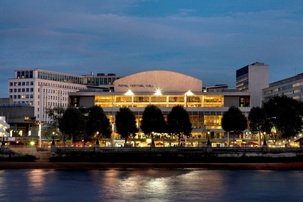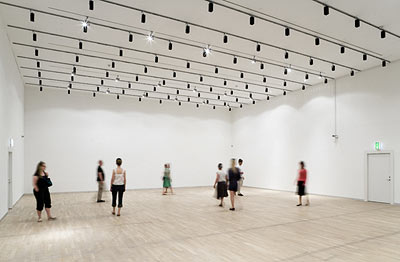|
We last posted about the Hayward Gallery's (London) latest exhibit, "Invisible: Art About the Unseen." Well, we found some more examples, including one called The Museum of Non-Visible Art perpetrated by our erstwhile intern, James Franco. For shame, Jimmie! And then there is the music which is not be to played by avant-garde composer, John Cage. Entitled 4'33" (Four minutes and 33 seconds), it requires the musician(s) playing any instrument(s) to NOT play for the entire duration of the piece, so we have four minutes and 33 seconds of SILENCE. Grab your favorite alcoholic (or non-alcoholic) beverage and settle back in your favorite chair for this amazing work of art:
1 Comment
 Southbank Centre (Courtesy of its website) Once there was, and once there was not, an art museum in London. It was called the Hayward Gallery and it was part of a humungous arts center (or "centre" as they spell it across the pond) that included venues for music, theatre and dance performances, as well as a fabulous library just for poetry of all kinds. It sprawled on the south bank of the River Thames (hence its name "Southbank Centre"), stretching all the way from Waterloo Bridge (made famous by a Vivien Leigh movie and a Kinks song) to the London Eye (a gigantic Ferris Wheel). It was quite the place for Art with a capital "A."  Soviet Bloc-- oops, the Hayward Gallery (courtesy of website) Now the Hayward Galley was an ugly building on the outside, fortress-like, with a facade of massive, jutting concrete blocks. This was called "Brutalist" architecture and was apparently all the rage starting in the 1950's and running through the mid-'70's, and it did in fact remind an observer of the Cold War, totalitarianism and Soviet Union-era apartment blocks. But I digress. Anyway, the Hayward did not house any permanent art collections. Instead, it hosted three or four temporary exhibitions each year. Millions of art lovers passed through its chrome and glass doors to view historic works by Leonardo DaVinci, Edvard Munch and the French Impressionists, as well as modern and contemporary art by Pop artist Roy Lichtenstein (the cartoon-dot guy) and sculptor Antony Gormley. The curators of the Hayward were tossing ideas around for a new exhibition one winter's day when a horrendous blizzard struck the heart of London, the worst in a century, rendering the known world invisible in a cloak of blinding white. The curators stared out the windows into... a white void... and suddenly it dawned on them in a moment of simultaneous ideaism. "Ah hah! By Jove! That's the ticket!" they shouted (or whatever Brits exclaim when the lightbulb goes on above their heads). "Invisible art! Come on, let's put on a show!" So they set out to scour the world for 50 works of art that no one could see. Surprisingly, their quest proved not too hard to achieve, because over the past 70 years, painters and sculptors and other "artistes" had apparently been making lots of invisible art!  Or did he mean he was the art? They scooped up a sculpture by American artist Andy Warhol that he did not create and exhibit at the New York nightclub, Area, in May of 1985. The art consisted of an empty pedestal with a label: "Andy Warhol, USA/Invisible Sculpture/Mixed Media, 1985." He hung around it for awhile, posing awkwardly, then walked away. Brilliant!! Next, they wrangled a Claes Oldenburg piece titled "Proposed Underground Memorial and Tomb for President John F. Kennedy" that was not constructed in 1965. It would have been a hollow bronze casting the size of the Statue of Liberty, buried upside down. Through an opening "about the size of a golf ball," a spectator could have viewed the interior by kneeling or lying down, eyeball to the hole. Extraordinary!!  Klein staring at his exhibit "Void Room" The curators took the Chunnel over to France to take a gander at the non-works of French artist provocateur Yves Klein, who stunned the Parisian art world in 1958 with a show that consisted of an entirely empty gallery (yes, blank white walls) which he insisted were filled to the brim with an invisible "blue sensibility." Klein also proposed "Air Architecture," an immaterial architecture made of the elements of nature, such as air, fire and water. For example, if you lived in a cooler Northern climate, you would have a wall of fire. In the hot South, your walls would be of refreshing water. (Who knows what would happen in a drought!) Anyway, you get the picture and are probably asking yourself: "What was he smoking?" I'm guessing it wasn't just Gitanes. Moving on to Copenhagen, they made a particularly intriguing find: the "Invisible Labyrinth" by Danish artist Jeppe Hein. "Just look at this," one said. "Our visitors will wear digital headphones that vibrate whenever they knock into one of the invisible walls of the maze!" "Oh, won't it be hysterical?" replied the other. "Watching them make complete and utter fools of themselves traipsing around an empty room, bumping into things that aren't there?!" Smashing!! They came upon an artist named Tom Friedman who specialized in invisible art and fell in love with a work he claimed took five years to create. It was a blank sheet of paper (not even canvas), 32 1/2 by 32 1/2 inches square, entitled "1,000 Hours of Staring, 1992-97." "It's exquisite! But what media did you use?" they asked. "Stare on paper," he replied.  Bruno Jacob: Untitled (Horse) (courtesy of exhibit) They traveled the continents until they had gathered 49 pieces to exhibit. They were exhausted by their efforts. "Let's go home," said one. "49 pieces of invisible art are enough." "Wait! I've found the 50th!" shouted the other. "We can't possibly not include this one. It's a photo of the artist showing a blank canvas to a white horse." "Oh, now that is either deep..." "Or a pile of horsesh--t!" They were truly ROFLMFAO by now. They chortled and guffawed as they hauled all the invisible art back to the gallery and hung it on the walls and arranged it on white pedestals and plinths. They tediously printed all the exhibit labels in a SERIOUS font and attached them neatly next to the works. They labored over a fine catalog to accompany the exhibit, printed on luxurious, real paper that you could actually see, touch and smell. At long last, they proclaimed to the world that their exhibit was open. And people came from far and wide to pay real money to oooh and aaah over the empty galleries, blank canvases and barren sculptural plinths.  Visitors revel in the sensual pleasure for the eye. "Well, what do you think?" "Hmm, I don't know. What do you think?" "Let me just stare a minute whilst I ponder." "Alright then, I'll stare as well." Time passed. "Well?" "Could be an incredibly prescient exploration of the power of the imagination." "Could be the apotheosis of conceptual art nonsense." "WTF?" "A big joke." The small child ran from room to room, searching for something to see. He tugged at his mother's stylish black tunic. His voice was a rather loud whine, an assault to the ears in the hushed gallery. "But Mummie, you said we were going to see some art. And there is nothing here!" It's no fairytale.
If you don't believe me, you can check it out at The Hayward Gallery: Invisible: Art About the Unseen 1957-2012. It's all a bit too much for me. Call me a material girl, but I like my art to be, well, material. |
AuthorTo find out more about me, click on the Not Your Average Jo tab. Archives
February 2024
Categories
All
|




 RSS Feed
RSS Feed